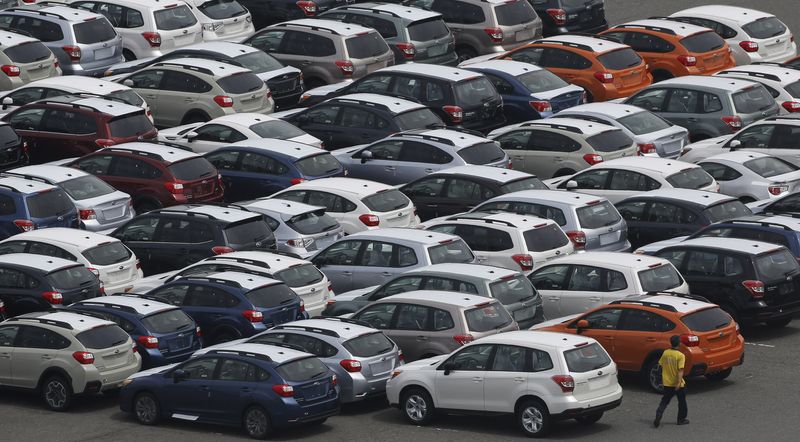Japan exports grow unexpectedly on solid car sales, global demand still uneven
2023.06.15 04:08

© Reuters. FILE PHOTO: A worker walks beside newly produced cars ready for shipment at a port in Kawasaki, south of Tokyo May 21, 2013. REUTERS/Toru Hanai
By Tetsushi Kajimoto and Kantaro Komiya
TOKYO (Reuters) -Japan’s exports grew unexpectedly in May on robust car sales, though the rate of expansion slowed to a crawl as inflation and rising interest rates bit into global demand, highlighting a patchy recovery in the world’s third-largest economy.
While the country’s hotels, restaurants and other service sector companies have seen a boom in business since COVID curbs were eased, its factories have been struggling amid weakening demand for cyclical items such as chip-making machines.
Ministry of Finance data showed on Thursday that exports rose 0.6% year-on-year in May, for the 27th straight month of rises, led by 66% growth in car shipments.
The overall exports growth was the slowest since February 2021, but the outcome beat a 0.8% year-on-year decrease expected by 16 economists in a Reuters poll, and followed a 2.6% rise in April.
“Semi-conductor equipment and related exports were the main sources of export weakness, which chimes with the sharp drop in exports to countries like Taiwan and South Korea…offset by continued strength in motor vehicle exports,” said Darren Tay, Japan economist at Capital Economics.
This year, domestic demand may temporarily outpace slumping exports as a key driver of growth, said Takeshi Minami, chief economist at Norinchukin Research Institute.
Separate government machinery orders data, also released Thursday, underlined the struggles faced by manufacturers though the overall numbers suggested the services sector is providing some cushion to the economy.
Core machinery orders rose 5.5% in April from the previous month, the first increase in three months and above the median forecast for a 3.0% gain. While orders from manufacturers were down 3.0%, an 11.0.% growth in service-sector demand for items such as computers drove up the headline figure.
On a year-on-year basis, core orders, a highly volatile data series regarded as a leading indicator of capital spending in the coming six to nine months, fell 5.9%, versus a forecast for a decline of 8.0%, the Cabinet Office data showed.
IMPORTS STILL WEAK
The data will be among other key indicators to be scrutinised by the Bank of Japan as it holds two-day policy setting meeting that ends on Friday.
Japan’s gross domestic product (GDP) expanded an annualised 2.7% in January-March, much higher than a preliminary estimate of a 1.6% growth, as revised capital expenditures and firm private consumption more than offset the slowdown in external demand.
The trade data also showed imports fell 9.9% in the year to April, down for the second straight month on softening commodity prices, versus the median estimate for a 10.3% decrease.
The trade balance came to a deficit of 1.3725 trillion yen ($9.80 billion), versus the median estimate for a 1.3319 trillion yen shortfall.
By region, Japanese exports to China, the country’s largest trading partner, fell 3.4% year-on-year in May for their sixth month of decrease, due to shrinking steel and auto parts shipment, although items such as cars and semiconductors recorded growth.
U.S.-bound exports, another key market for Japanese exports, grew 9.4% in the year to May on double-digit gain in car shipment.
“For the outlook of Japanese exports, the U.S. Fed’s rate-hike pause is a positive news that will further vitalise American private consumption”, said Kazuma Kishikawa, economist at Daiwa Institute of Research.
“With recovery in Chinese goods spending and easing supply bottlenecks for Japanese manufacturers, Japan’s export volume will gradually pick up.”
($1 = 140.0300 yen)








